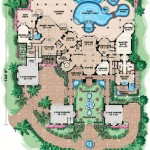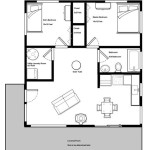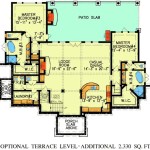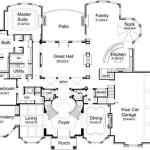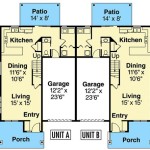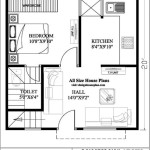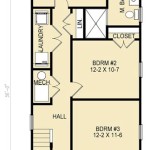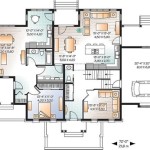Affordable 2 Bedroom House Plans: Balancing Budget and Functionality
The dream of homeownership is a widely shared aspiration, but the financial realities can often present significant hurdles. Building a house, particularly a new one, necessitates careful planning and resource management. For individuals, couples, or small families operating on a budget, affordable 2 bedroom house plans offer a practical and achievable pathway to realizing that dream. These plans are designed to minimize construction costs while maximizing living space and functionality, ensuring a comfortable and sustainable home environment.
Affordability in house plans doesn't necessarily equate to sacrificing quality or aesthetics. Instead, it emphasizes efficient space utilization, simpler designs, and the use of cost-effective building materials. A well-designed 2 bedroom house can provide ample living area, separate bedrooms, a functional kitchen, and adequate bathroom facilities, all within a reasonable budget. This article explores key considerations and factors involved in selecting and implementing affordable 2 bedroom house plans.
Optimizing Space and Layout
The cornerstone of an affordable 2 bedroom house plan lies in its space optimization strategies. Maximizing usable square footage while minimizing wasted space is paramount. This can be achieved through several architectural and design approaches.
Open-concept living areas are commonly employed to create a sense of spaciousness. Combining the living room, dining area, and kitchen into a single, interconnected space reduces the need for dividing walls, thereby lowering construction costs and improving natural light distribution. Thoughtful furniture placement and strategic zoning can effectively define distinct areas within the open layout.
Compact kitchen designs are also crucial. Utilizing efficient layouts such as galley kitchens or L-shaped configurations can reduce the overall footprint of the kitchen without compromising functionality. Incorporating space-saving appliances, such as smaller refrigerators or combination microwave-convection ovens, further contributes to space efficiency.
Bedroom sizes should be adequate but not excessively large. Prioritizing functionality over sheer size is essential. Built-in storage solutions, such as wardrobes and shelving, can maximize storage capacity within the bedrooms, reducing the need for bulky furniture that occupies valuable floor space. The strategic placement of windows for natural light and ventilation can also enhance the perceived spaciousness of the bedrooms.
Bathroom design should also prioritize efficiency. Opting for a single, well-designed bathroom instead of multiple smaller bathrooms can significantly reduce plumbing costs and square footage requirements. Incorporating a shower-tub combination instead of separate shower and bathtub units can further optimize space utilization. Wall-mounted sinks and toilets can also contribute to a more streamlined and space-saving bathroom design.
Effective use of vertical space can also contribute to affordability. Utilizing attic space for storage or considering a two-story design (if lot size permits) can expand the usable living area without significantly increasing the foundation footprint. However, the added cost of stairs and second-story construction must be carefully weighed against the benefits of increased space.
Selecting Cost-Effective Building Materials
Choosing the appropriate building materials plays a critical role in controlling construction costs. Opting for readily available and locally sourced materials can significantly reduce transportation expenses and material acquisition costs.
Concrete block construction is a popular choice for affordable housing due to its durability, fire resistance, and relatively low cost. While it may require additional insulation to meet energy efficiency standards, the overall cost-effectiveness makes it an attractive option. Wood frame construction is another common choice, particularly for single-story homes. It offers flexibility in design and is generally less expensive than concrete block construction, but it may require more maintenance over time.
Exterior cladding options also have a significant impact on cost. Vinyl siding is a popular choice for its affordability, low maintenance requirements, and wide range of color options. Fiber cement siding offers a more durable and aesthetically pleasing alternative, but it comes at a higher cost. Brick veneer is another option, providing a classic look and excellent durability, but it is typically more expensive than vinyl or fiber cement siding.
Roofing materials also contribute to the overall cost of the house. Asphalt shingles are the most common and affordable roofing option, offering a good balance of durability and cost-effectiveness. Metal roofing is a more durable and energy-efficient alternative, but it is typically more expensive upfront. Clay tiles offer a classic and durable roofing option, but they are also among the most expensive.
Interior finishes should also be selected with cost in mind. Laminate flooring is a cost-effective alternative to hardwood flooring, offering a similar aesthetic at a fraction of the price. Ceramic tile is a durable and affordable option for bathrooms and kitchens. For countertops, laminate countertops are the most affordable option, while granite and quartz countertops offer greater durability and aesthetic appeal but at a higher cost.
Windows and doors should be energy-efficient to reduce long-term energy costs. Vinyl windows are a popular choice for their affordability and energy efficiency. Insulated doors are also important for minimizing heat loss and gain. Consider the size and placement of windows to maximize natural light and ventilation, reducing the need for artificial lighting and air conditioning.
Simplifying the Design and Construction Process
The complexity of the house design directly influences the cost of construction. Simpler, more streamlined designs are generally less expensive to build than elaborate, custom designs.
Rectangular or square floor plans are typically more cost-effective than irregularly shaped floor plans. Simple rooflines, such as gable or hip roofs, are also less expensive to construct than complex rooflines with multiple gables or dormers. Avoiding unnecessary architectural details, such as excessive trim or decorative elements, can also help to reduce costs.
Standardized building materials and construction techniques can also contribute to affordability. Using readily available materials and common construction methods reduces the need for specialized labor and equipment. This can also speed up the construction process, reducing labor costs.
Careful planning and coordination are essential for a successful and affordable construction project. Thoroughly researching and selecting reputable contractors is crucial. Obtaining multiple bids from different contractors allows for comparison and negotiation, ensuring the best possible price. Clear and detailed contract agreements are essential for avoiding misunderstandings and disputes during the construction process.
Consider modular or prefabricated house plans. These types of plans involve constructing sections of the house in a factory setting and then assembling them on the building site. This method can significantly reduce construction time and labor costs. Modular homes are also typically built to higher quality standards than site-built homes, as they are constructed in a controlled environment.
Reducing the number of changes made during the construction process is also important for controlling costs. Changes made after construction has begun can be expensive and time-consuming. Careful planning and attention to detail during the design phase can help to minimize the need for changes later on.
Obtaining all necessary permits and approvals before beginning construction is essential. Failure to obtain required permits can result in costly delays and fines. Working with a qualified architect or engineer can help to ensure that the house design meets all applicable building codes and regulations.
Finally, consider phasing the construction process. If budget constraints are a major concern, it may be possible to build the house in stages. For example, the basic structure could be built first, followed by interior finishes and landscaping at a later date. This allows for spreading out the costs over time and making the project more manageable.

2 Room House Plans Low Cost Bedroom Plan Nethouseplans

2 Room House Plans Low Cost Bedroom Plan Nethouseplans

2 Room House Plans Low Cost Bedroom Plan Nethouseplans

House Plan Ch265

Unique Small 2 Bedroom House Plans Cabin Cottage

Knock Down Two Bedroom Prefab Collapsible Ready Made Homes Modular House Container In Com

2 Bedroom Budget House Design With Floor Plan Home Idea

Prairie Plan 998 Square Feet 2 Bedrooms 1 5 Bathrooms 035 01020

House Plan 2 Bedrooms 1 Bathrooms 1904 Drummond Plans

2 Bedroom Apartment House Plans

